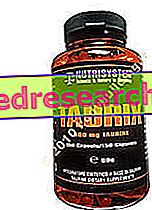What are
What are canned cherries?
The cherries in syrup are long-life foods that belong to the whole of the preserved fruit and fruit in syrup subset.

Fresh cherries - fruits of the Prunus avium tree - like all pulpy and acid fruits, belong to the VI or VII fundamental group of foods - fruits and vegetables rich in vitamin A or vitamin C. They also contain fructose - which outlines an energy supply medium - a lot of water and specific minerals, especially potassium. However, once transformed into "preserves" - washing, cutting, pitting, cooking and potting in a sweet liquid - the vitamin concentration tends to decrease significantly. Moreover, compared to the fresh ones, the cherries in syrup are much richer in soluble / simple sugars and calories. This gives you a high glycemic-insulin load; they are therefore not very suitable for clinical nutrition, especially for overweight, type 2 diabetes mellitus and hypertriglyceridemia. An excess of sugar can promote the formation of tooth decay. Note : in order to improve conservation, in the industrial sector the fruit in syrup is enriched with antioxidant additives - especially vitamin C or ascorbic acid, like the many types of ascorbate.
The recipe for cherries in syrup is quite simple. The steps required to increase shelf life are cooking and sterilizing; taking for granted an adequate heat treatment, the most important step - but also the most delicate - to obtain cherries in syrup with a perfect consistency - even in the long term - is certainly the formulation of the syrup.
In the kitchen, cherries in syrup are mainly used as desserts, sometimes accompanied by whipped cream and / or liqueurs and / or chocolate flakes and / or biscuits - even crumbled. It is advisable to eat them away from the main meals, so as not to reach too high a glycemic load; they can be a snack or an ingredient for breakfast. Different recipes contain cherries in syrup even though, generally, they are common for excessive calories and simple sugars compared to the needs of an ordinary diet; a classic example is the "Spanish" ice cream taste, but the cherries in syrup are also used for many types of cakes - especially cold ones - such as cheesecake - or for various desserts - such as semifreddi.
Why syrup cherries?
The invention of syruping is due to the need to prolong the preservation of fresh fruits, excessively available in a limited period of time - that of maturation. From the cherries you can also get excellent jams, jellies, candied or dehydrated / dried fruit pieces. Although these are various methods for preserving fresh fruit, not all of them apply the same criteria.
For example, while obtaining the fruit in syrup or in spirits requires the almost complete "integrity" of the raw materials, to produce jam or marmalade the fruits can also be peeled and cut because they will be reduced to a pulp during cooking. It is no coincidence that the cherries harvested too ripe, perhaps bruised, marked by hail, mold or vermin - therefore unsuitable for the production of syrup - are destined for jam or jelly. Cherries in syrup, in spirit, candied and dehydrated on the other hand, require more intact raw materials and a much higher expenditure of energy and resources.
It should however be specified that the consumption of preserved fruit was more common in the past than in the present day. Then, "healthy" products were mostly eaten fresh; alternatively, those who could afford it - not everyone could buy large quantities of sugar - produced canned fruit in syrup, candied fruit or jelly. The dented fruits instead, partially moldy, vermin or in any case to be cleaned and cleaned, were turned into jam - which can be obtained even without the addition of sugar, allowing the mixture to boil for longer.
Nutritional Properties
Nutritional properties of cherries: fresh VS in syrup
Containing vitamin A - mainly retinol equivalents (RAE), or carotenoids - and vitamin C - ascorbic acid - cherries are framed in both the VI and VII basic food group.
Raw and fresh, they have a moderate energy supply and an excellent percentage of water. Calories are provided mainly by soluble / simple sugars, or fructose monosaccharide; proteins - with a low biological value - and lipids are marginal. They contain a good amount of dietary fiber. Note : The presence of fructose - instead of glucose, sucrose or maltose - and fiber helps to define a medium-low entity glycemic-insulin index.
Instead, they are cholesterol free. No traces of lactose, gluten or histamine are detected. They have a low level of purines and phenylalanine amino acid. The amount of minerals, especially potassium, is satisfactory. As for vitamins, in addition to equivalent retinol - carotenoids - and vitamin C, the dose of folic acid is more than fair. Note : The contribution of retinol equivalents (RAE), but especially that of polyphenols - antioxidant elements that participate in attributing the dark color to cherries - can change significantly depending on the variety and the state of ripeness.
Cherries in syrup, on the other hand, have a much higher energy intake, more than twice as much as fresh raw ingredients. The added calories are provided by sugar - sucrose disaccharide or monosaccharides glucose and fructose - used for syrup. Proteins and lipids have even less relevance than fresh fruits. Not being peeled, the cherries in syrup contain the same amount of dietary fiber; however, thanks to cooking, part of the latter undergoes partial hydrolysis, becoming more digestible and available to the intestinal bacterial flora - prebiotic function. However, cholesterol and lactose are absent; similarly, purines and phenylalanine appear in modest concentrations. With regard to histamine instead, it should be noted that, in principle, it is present at higher concentrations in preserved foods than in fresh ones. The mineral profile is inferior, due to the dilution in the governing liquid. The same applies to the vitamin concentration which, moreover, is drastically reduced following cooking and oxidative stress. Retinol equivalents (RAE or provitamin A) are not as strong as those of ascorbic acid (vitamin C) and folic acid.
Diet
Cherries in syrup in the diet
The increase in glycemic load, total calories and glycemic-insulin index, make syruped cherries an unsuitable food for the diet against overweight, hyperglycemia or type 2 diabetes mellitus and hypertriglyceridemia. They are also not recommended for subjects predisposed to tooth decay.
The fiber intake is discreet and could help - despite the lower portion compared to fresh food - to satisfy the daily dietary intake. Dietary fibers are useful in reducing the glycemic index, increasing the sense of satiety and modulating intestinal absorption. They also have a beneficial effect on the intestine, improving alvo and preventing or treating a series of disorders and even serious pathologies: constipation, diverticulosis and diverticulitis, inflammation of hemorrhoids, anal fissures and anal prolapse; a high fiber diet reduces the incidence of some colon cancers.
Provitamin A and vitamin C are two powerful antioxidants; folic acid, on the other hand, plays a necessary role in the synthesis of nucleic acids, which is why it is necessary in pregnancy. It is however necessary to consider that, with cooking, the thermolabile molecules - ascorbic acid and folic acid - undergo an irreversible degradation. Note : the addition of antioxidant additives in commercial products compensates, at least in part, for the reduction of vitamin C.
Potassium is an alkalizing mineral of which the body has a high daily requirement. This ion participates in the transmission of the neuromuscular action potential, which is why a possible deficiency almost inexorably results in the onset of muscle cramps - more frequent with increasing sweating. The increase in potassium in the diet also participates in combating the possible presence of primary hypertension.
It must however be specified that, despite the content of some useful nutrients, the excess sugar in cherries in syrup still has a very bad impact on the metabolism. Furthermore, the recommended portions are fairly small (50 g) and therefore do not contribute significantly to achieving the recommended daily intake of these nutrients. For both these reasons, cherries in syrup cannot be considered a primary source of vitamins, minerals and dietary fiber.
recipe
Recipe of cherries in syrup
Below we will briefly summarize how to prepare syruped cherries quickly and easily.
Ingredients of cherries in syrup
- 900 g of cherries
- 300 g of granulated sugar
- 135-140 ml water
- protective antioxidants (eg vitamin C).
Tools for preparing syruped cherries
Knife, cutting board, glass jars and lids, pots and lids, twists or cloths and pot holders, hob.
Process of syruped cherries
- Wash glass jars and lids
- Sterilize them in boiling water inside a muffler or saucepan
- Boil water in another pot
- Wash the cherries
- Blanch the cherries in water for 5-10 "
- Drain and cool them in ice water
- Cut them in half and stone them
- Dip the cherries in the protector according to the instructions on the package
- Put sugar and water in another saucepan; bring to a boil
- Place the cherries in the jars and cover with the syrup by removing the air bubbles
- Place the lids on the jars without tightening them
- Put the jars back into the pot with the water for sterilizing the jars
- Bring to a boil and keep for 25-30 '
- Remove the jars from the hot water and tighten the lids
- Cool and check the vacuum seal.
Frequent errors in the preparation of cherries in syrup
Cherries in syrup become swollen and soggy or small and hard with preservation
If the cherries in syrup become swollen and soggy it is certainly the fault of the syrup, in particular of its osmotic power - called "strength". If too concentrated, the syrup tends to dehydrate the fruit making it hard; if too diluted it pushes the water inside the plant tissues making them swell. The ideal strength of the syrup should be around 20 ° Baumé - proportion of the sugar in bulk - or 145-145 / S (S = specific mass of the sugar). It is an equation that varies according to the osmotic power of the pulp used; it changes from one fruit to another, but the diversity is relevant only by changing the Botanical species - for example by replacing the cherries with grapes without peel. For more details, please read our article: Fruits in Syrup.
Cherries are not kept and fermented
If the cherries in syrup are not kept and fermented, the fault can be of two factors:
- Insufficient cooking or sterilization ineffective: it consists in applying temperatures that are too low or suitable but for an insufficient time
- Impairment of the hermetic seal: generally caused by a defect in the gasket or the shape of the cap.



